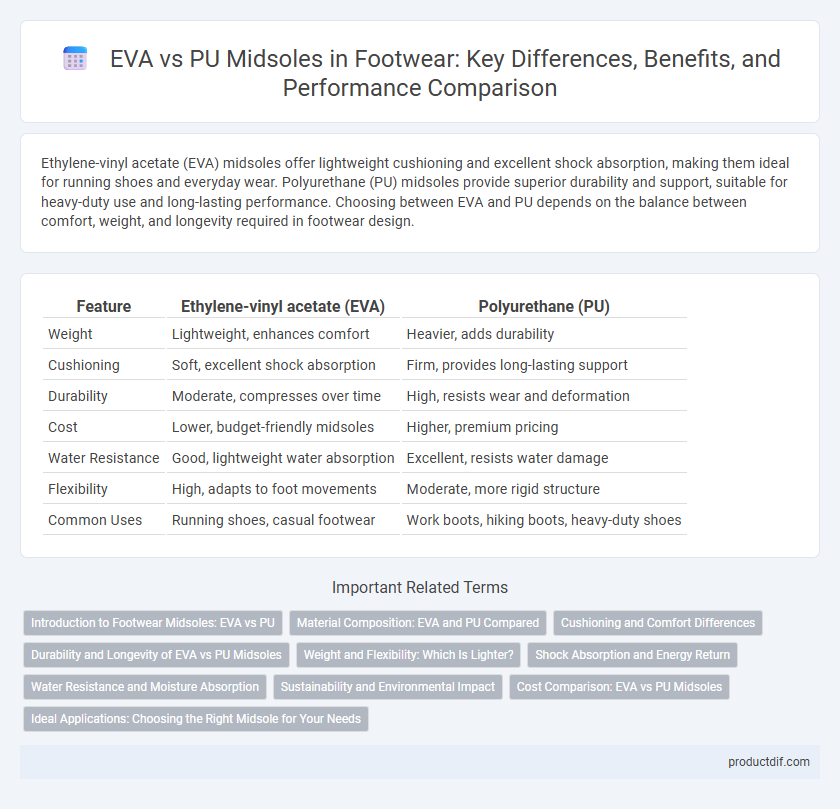Ethylene-vinyl acetate (EVA) midsoles offer lightweight cushioning and excellent shock absorption, making them ideal for running shoes and everyday wear. Polyurethane (PU) midsoles provide superior durability and support, suitable for heavy-duty use and long-lasting performance. Choosing between EVA and PU depends on the balance between comfort, weight, and longevity required in footwear design.
Table of Comparison
| Feature | Ethylene-vinyl acetate (EVA) | Polyurethane (PU) |
|---|---|---|
| Weight | Lightweight, enhances comfort | Heavier, adds durability |
| Cushioning | Soft, excellent shock absorption | Firm, provides long-lasting support |
| Durability | Moderate, compresses over time | High, resists wear and deformation |
| Cost | Lower, budget-friendly midsoles | Higher, premium pricing |
| Water Resistance | Good, lightweight water absorption | Excellent, resists water damage |
| Flexibility | High, adapts to foot movements | Moderate, more rigid structure |
| Common Uses | Running shoes, casual footwear | Work boots, hiking boots, heavy-duty shoes |
Introduction to Footwear Midsoles: EVA vs PU
Ethylene-vinyl acetate (EVA) midsoles provide lightweight cushioning and superior shock absorption, making them ideal for running shoes and casual footwear. Polyurethane (PU) midsoles offer increased durability and support due to their higher density and resilience, often preferred in work boots and high-performance athletic shoes. Choosing between EVA and PU depends on factors like weight, comfort, longevity, and the specific activity demands on the footwear.
Material Composition: EVA and PU Compared
Ethylene-vinyl acetate (EVA) midsoles are lightweight, flexible, and offer excellent shock absorption due to their closed-cell foam structure, making them ideal for running and casual footwear. Polyurethane (PU) midsoles consist of a denser, more durable material that provides superior support and resilience, often used in work boots and athletic shoes requiring long-lasting cushioning. The chemical composition of EVA, a copolymer of ethylene and vinyl acetate, contributes to its softness and compressibility, while PU's blend of polymer chains delivers enhanced toughness and abrasion resistance.
Cushioning and Comfort Differences
Ethylene-vinyl acetate (EVA) midsoles offer lightweight cushioning with excellent shock absorption, making them ideal for running shoes and casual footwear. Polyurethane (PU) midsoles provide denser, more durable cushioning that maintains support and resilience over time, preferred in work boots and high-performance athletic shoes. EVA emphasizes softness and flexibility, while PU delivers long-lasting comfort and structural stability under repeated impact.
Durability and Longevity of EVA vs PU Midsoles
Ethylene-vinyl acetate (EVA) midsoles offer lightweight cushioning but tend to compress and degrade faster under prolonged use compared to polyurethane (PU) midsoles, which provide superior durability and maintain structural integrity over time. PU midsoles resist cracking, abrasion, and deformation, making them ideal for footwear demanding long-term resilience and consistent performance. Choosing PU midsoles enhances longevity and supports sustained impact absorption in high-wear environments.
Weight and Flexibility: Which Is Lighter?
Ethylene-vinyl acetate (EVA) midsoles are significantly lighter than polyurethane (PU) midsoles, making them a preferred choice for lightweight footwear. EVA offers superior flexibility, enhancing comfort and mobility during activities that demand dynamic foot movement. Polyurethane midsoles, while durable, tend to be heavier and less flexible, which can affect the overall weight and responsiveness of the shoe.
Shock Absorption and Energy Return
Ethylene-vinyl acetate (EVA) midsoles offer superior shock absorption due to their lightweight and flexible foam structure, effectively reducing impact on joints during activity. Polyurethane (PU) midsoles provide enhanced energy return and durability, with a denser composition that delivers consistent cushioning and resilience over time. EVA excels in cushioning and comfort for low-impact use, while PU benefits athletes requiring sustained energy efficiency and support in high-intensity footwear.
Water Resistance and Moisture Absorption
Ethylene-vinyl acetate (EVA) midsoles exhibit superior water resistance compared to polyurethane (PU), as EVA's closed-cell structure minimizes moisture absorption and prevents water retention. In contrast, PU midsoles tend to absorb more water due to their porous composition, resulting in increased weight and reduced cushioning performance over time. Water-resistant EVA midsoles provide enhanced durability and maintain lightweight comfort in wet conditions, making them ideal for outdoor and athletic footwear.
Sustainability and Environmental Impact
Ethylene-vinyl acetate (EVA) midsoles offer lightweight cushioning with lower carbon emissions during production compared to polyurethane (PU), making them a more sustainable choice for environmentally conscious footwear brands. However, EVA's non-biodegradable nature limits its end-of-life recyclability, whereas PU midsoles, often denser and heavier, can be engineered for improved durability and potential chemical recycling, reducing landfill waste. Evaluating the overall lifecycle impact reveals a trade-off between EVA's lower production footprint and PU's potential benefits in longevity and recyclability within sustainable footwear design.
Cost Comparison: EVA vs PU Midsoles
EVA midsoles generally cost less than polyurethane (PU) midsoles, making them a budget-friendly option in footwear manufacturing. While EVA provides excellent cushioning at a lower price point, PU midsoles, despite their higher cost, offer greater durability and support, which can extend the lifespan of the footwear. The cost difference between EVA and PU midsoles significantly impacts the overall price and performance trade-offs in athletic and casual shoes.
Ideal Applications: Choosing the Right Midsole for Your Needs
Ethylene-vinyl acetate (EVA) midsoles are ideal for lightweight, flexible footwear designed for running or casual use due to their excellent shock absorption and softness. Polyurethane (PU) midsoles provide greater durability and support, making them suitable for hiking boots, work shoes, and other high-impact activities requiring long-lasting cushioning and stability. Selecting EVA ensures enhanced comfort in low-impact settings, while PU is preferred for demanding environments where toughness and structural integrity are crucial.
Ethylene-vinyl acetate (EVA) vs Polyurethane (PU) midsoles Infographic

 productdif.com
productdif.com